When you buy through our links, we may earn a commission. Products or services may be offered by an affiliated entity. Learn more.
If you’re physically active, a good night’s rest is an especially important part of your recovery routine. Whether you run, bike, swim, or lift weights, a mattress that reduces pressure in your most sensitive areas and helps your body recover overnight can be an invaluable investment. And if your bed does not share these qualities, you might wake up feeling stiffer and more strained than before you turned off the light.
- A responsive mattress that sleeps cool, the Bear Elite Hybrid is our top pick. Athletes in our Test Lab liked the way it cradled their pressure points for extra comfort and support.
- We’ve outlined the mattress features that are beneficial for athletes, along with a few strategies for choosing a new bed based on your body and how you are active.
- Pressed for time? Watch our 1-minute video reviews of the best mattresses for athletes.
Our Top Picks
-
Best Mattress Overall – Bear Elite Hybrid
View Details
-
Best Value Mattress – Layla Memory Foam Mattress
View Details
-
Most Comfortable Mattress – Helix Midnight
View Details
-
Best Mattress for Back Pain – WinkBed
View Details
-
Best Mattress for Side Sleepers – Nolah Evolution 15
View Details
-
Best Mattress for Heavier Athletes – Titan Plus Luxe
View Details
Swipe for more
Best Mattress Overall
Bear Elite Hybrid
8.5 /10
Test Lab Score
40% sitewide with code: SF40
40% sitewide with code: SF40
The Bear Elite Hybrid combines cooling technology, copper infusions, and zoned coils in order to promote sound sleep in athletes. This mattress stands out for its optional Celliant cover, engineered to convert body heat into energy in order to help with muscle and joint recovery.
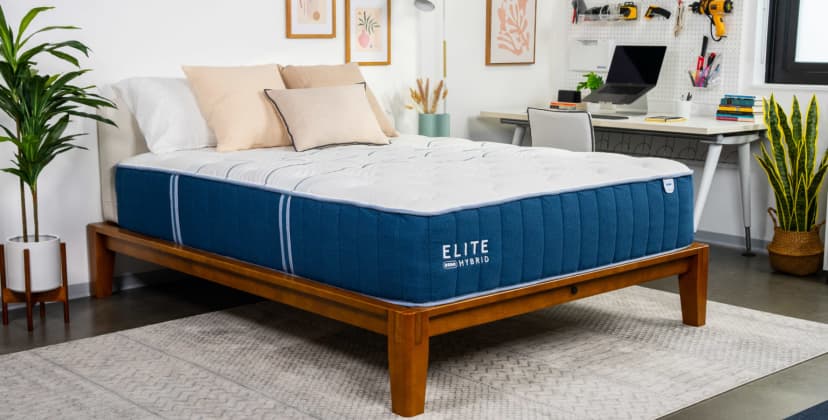
Credit: Sleep Foundation Test Lab
Price
$1,499
Mattress Type
Hybrid
Firmness Options
Medium (5), Medium Firm (6), Firm (8)
Trial Period
120 nights (30-night break-in period)
At a Glance
- Who It’s Best For: Side sleepers under 230 pounds (softest model), as well as heavier side sleepers and back sleepers across all weight groups (medium).
- Feel: Medium (5), medium firm (6), and firm (8) options. Some bounce but plenty of cushioning. Level of sink varies according to the firmness option.
- What It’s Made Of: Quilted cover with phase change material, comfort system is copper-infused memory foam and transitional polyfoam, and the support core is zoned pocketed coils featuring lumbar and edge reinforcement.
- What We Don’t Like: Extra charge for the Celliant cover. May be too thick for standard fitted sheets.
Scoring & Reviews
The following ratings show how suitable this mattress is for different sleeping positions and sleeper weights. These scores are determined by how well the mattress supports and relieves pressure for each sleeper type.
We performed a meta-analysis on 3703 validated customer reviews of the Bear Elite Hybrid. This is what people who bought the mattress had to say:- Comfort and Support: Many reviewers highlight the mattress’s balance of comfort and support, often mentioning relief from back pain and improved sleep quality.
- Firmness Options: Customers appreciate the various firmness options, with some opting for firmer versions after experiencing discomfort with medium firmness.
- Temperature Regulation: Several reviews note the mattress’s ability to stay cool, which enhances sleep quality, especially in hot weather.
- Size and Upgrade Options: Customers are pleased with the availability of different sizes and the option to upgrade, which provides flexibility for different needs and preferences.
- Quality of Additional Products: Positive remarks on the quality of accompanying products like pillows and sheets, which are often included as free additions.
- Motion Isolation: Many reviewers highlight the mattress’s excellent motion isolation, making it ideal for shared sleeping arrangements.
Best Value Mattress
Layla Memory Foam Mattress
8.4 /10
Test Lab Score
Get an extra $10 off with exclusive code: sleepy10
Get an extra $10 off with exclusive code: sleepy10
The Layla Mattress offers great value for money, with a sophisticated design and specialty materials not usually seen at such a low price-point. This flippable mattress features pressure-relieving foams to soothe sore muscles. The firm side offers a cool sleep surface, while the soft side stands out for its motion isolation.
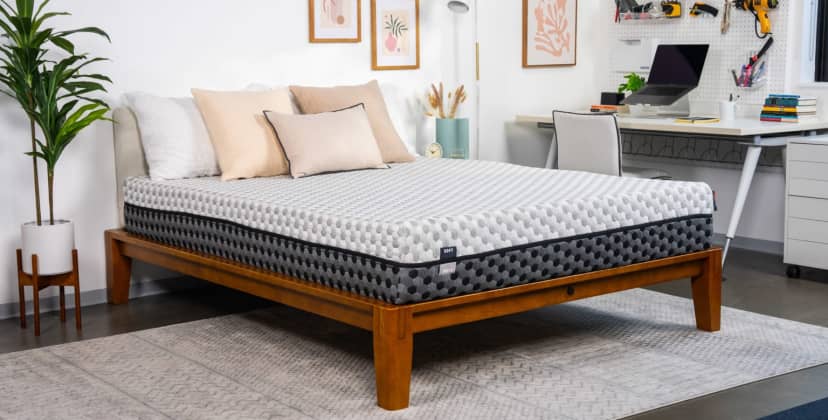
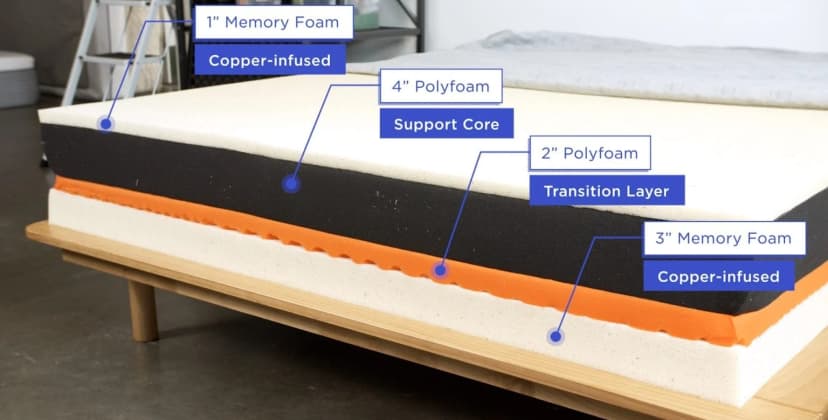
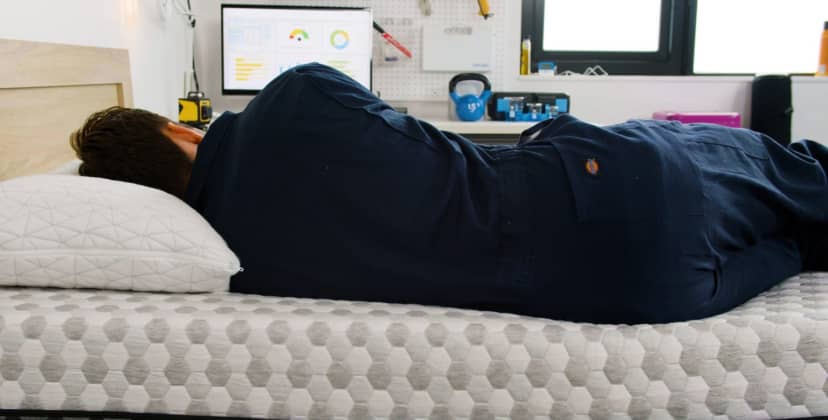
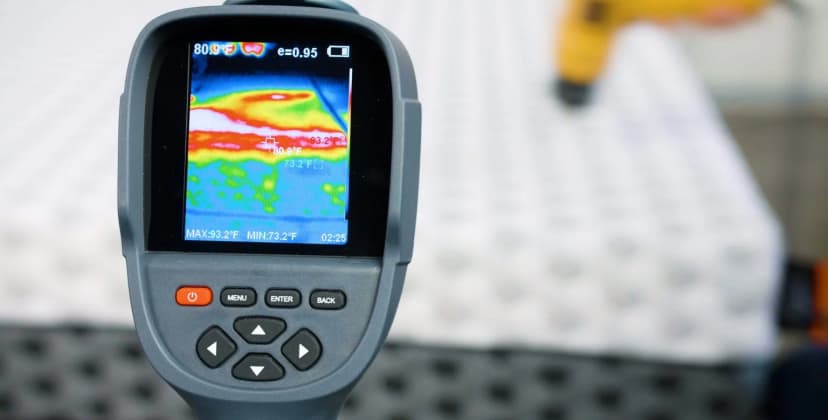
Credit: Sleep Foundation Test Lab
Price
$949
Mattress Type
Foam
Firmness Options
Medium Soft (4), Firm (7)
Trial Period
120 nights (4 week minimum)
At a Glance
- Who It’s Best For: Side sleepers (soft side) and back and stomach sleeping (firmer side).
- Feel: Cloud-like pressure relief, particularly on the medium soft (4) side. The firm (7) side offers sturdier support to keep the spine on an even plane.
- What It’s Made Of: Softer side has a layer of copper gel memory foam, plus a second layer of polyfoam with zoned grooves. The firmer side has just a thin layer of copper gel memory foam over a firmer polyfoam core, which provides support for both sides.
- What We Don’t Like: Not much bounce or pushback. Weaker edges than a hybrid.
Scoring & Reviews
The following ratings show how suitable this mattress is for different sleeping positions and sleeper weights. These scores are determined by how well the mattress supports and relieves pressure for each sleeper type.
We performed a meta-analysis on 7558 validated customer reviews of the Layla Memory Foam Mattress. This is what people who bought the mattress had to say:- Dual Firmness Options: The Layla Memory Foam Mattress offers both soft and firm sides, allowing users to choose according to their comfort preferences, which is highly appreciated for accommodating different sleeping styles.
- Comfort and Support: Many reviewers have noted the mattress provides exceptional comfort, helping alleviate back pain and improving overall sleep quality. The soft side is often described as cloud-like, while the firm side offers adequate support without being too hard.
- Quality and Durability: Users report that the mattress maintains its shape and comfort over time, with no significant sagging or indentations, even after several years of use, indicating good durability.
- Temperature Regulation: The mattress is generally reviewed as doing a good job of regulating temperature, preventing overheating during sleep, which is a common issue with many memory foam mattresses.
- Ease of Setup: Customers appreciate the ease with which the mattress can be set up. It is delivered in a box and expands quickly once unpacked, making it convenient for immediate use.
- Customer Service: Layla’s customer service receives high praise for being responsive and helpful, aiding customers with issues ranging from delivery to product inquiries and returns.
Most Comfortable Mattress
Helix Midnight
9.1 /10
Test Lab Score
25% off sitewide
25% off sitewide
With its thick, inviting comfort layers, the Helix Midnight is one of those mattresses that just begs you to fall into bed after a long day of training. Thanks to its coil support core, this hybrid mattress also boasts standout edge support and excellent temperature control, making it a great all-round choice for athletes.
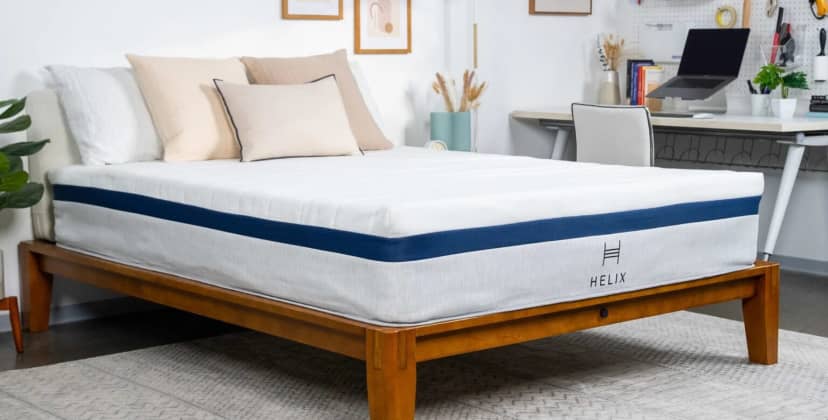
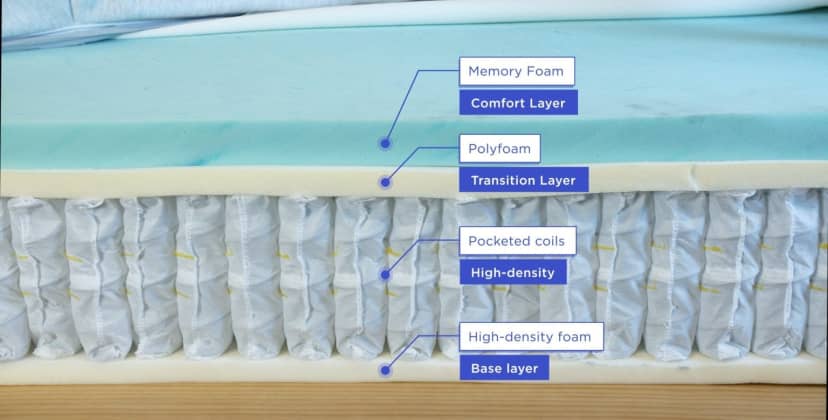
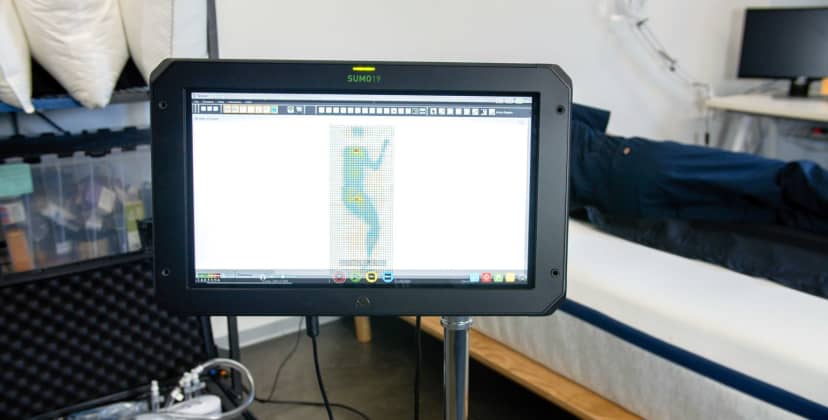
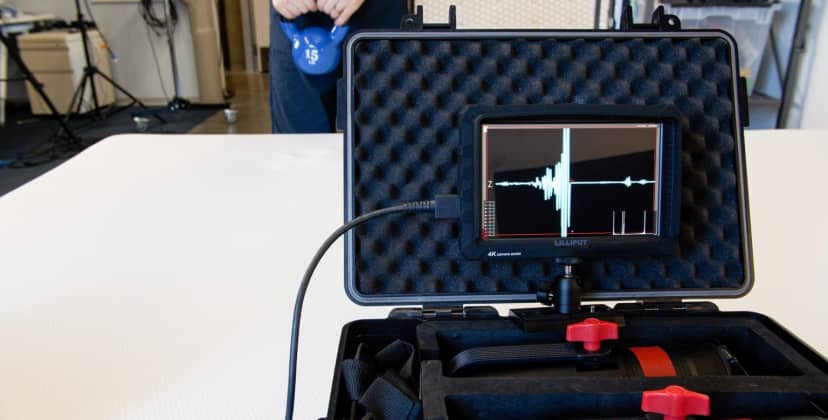
Credit: Sleep Foundation Test Lab
Price
$1,099
Mattress Type
Hybrid
Firmness Options
Medium Firm (6)
Trial Period
120 nights (30-night requirement)
At a Glance
- Who It’s Best For: Side and back sleepers, especially those between 130 and 230 pounds, as well as couples.
- Feel: Medium firm (6). Some pushback with foam-like comfort.
- What It’s Made Of: Breathable knit cover, with an optional upgrade to a cooling cover. Layers of memory foam and polyfoam, a pocketed coil support core with reinforced sides on top of a polyfoam base layer.
- What We Don’t Like: Too soft for stomach sleepers.
Scoring & Reviews
The following ratings show how suitable this mattress is for different sleeping positions and sleeper weights. These scores are determined by how well the mattress supports and relieves pressure for each sleeper type.
We performed a meta-analysis on 6653 validated customer reviews of the Helix Midnight. This is what people who bought the mattress had to say:
- Comfort and Firmness: Most reviewers praised the mattress for its medium-firm feel, which strikes a balance between support and plushness. Side sleepers in particular reported enhanced comfort due to effective cradling of pressure points.
- Heat Regulation: While many found the mattress sufficiently cool, some customers noted slight heat retention, which is typical for mattresses with foam comfort layers.
- Pain Relief: A standout theme was relief from back, hip, and shoulder pain. Customers with chronic pain or those who sleep on their sides frequently noted a reduction in discomfort.
- Durability Concerns: A minority of reviewers reported early signs of sagging or indentations, raising concerns about long-term durability.
- Sleep Quality: Numerous customers mentioned improved sleep quality, citing deeper, uninterrupted rest as a key benefit.
- Edge Support: Reviews indicated mixed opinions, but the mattress generally supports weight well at the edges, aligning with what hybrid beds typically offer.
Best Mattress for Muscle Recovery
Brooklyn Bedding Spartan
8.4 /10
Test Lab Score
30% off sitewide
30% off sitewide
The Brooklyn Bedding Spartan features copper-infused foam, cooling gel, and a fabric designed to stimulate blood flow for faster muscle recovery. Sold in soft, medium, or firm options, this mattress delivers the well-rounded performance you would expect from a hybrid, with strong ratings for edge support, ease of movement, and temperature neutrality.
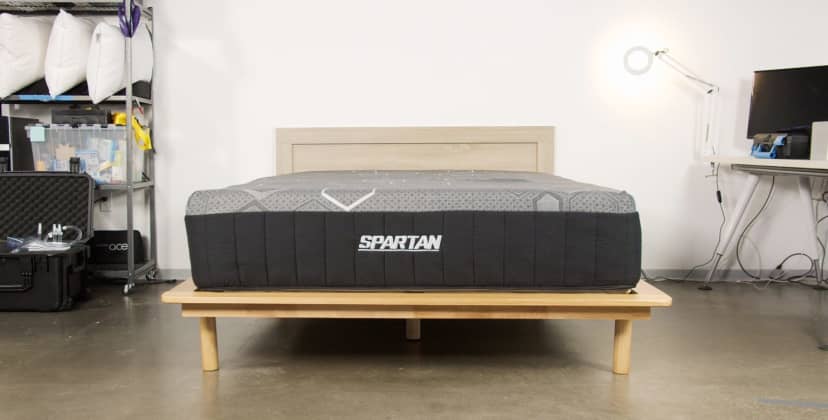



Credit: Sleep Foundation Test Lab
Price
$1,399
Mattress Type
Hybrid
Firmness Options
Medium Soft (4), Medium Firm (6), Firm (7)
Trial Period
120 nights (30-night requirement)
At a Glance
- Who It’s Best For: Sleepers across all weight groups and sleeping positions, depending on model.
- Feel: The soft (4) model lets sleepers sink in a little more, while the medium firm (6) model provides looser contouring, and the firm (7) model mostly keeps sleepers on top of the bed.
- What It’s Made Of: Far infrared technology in the cover. Copper-infused foam with cooling phase change material, followed by layers of responsive polyfoam and gel memory foam. The mattress has an 8-inch pocketed coil system with 3-zone support and reinforced sides.
- What We Don’t Like: Couples with very different sleep styles may find it hard to compromise. Returns fee of $99.
Scoring Breakdown
The following ratings show how suitable this mattress is for different sleeping positions and sleeper weights. These scores are determined by how well the mattress supports and relieves pressure for each sleeper type.
Best Mattress for Back Pain
WinkBed
9.4 /10
Test Lab Score
30% off all WinkBeds mattresses
30% off all WinkBeds mattresses
Finding a mattress with strong spinal support is crucial if you want to prevent back pain while sleeping. The WinkBed layers pressure-relieving foams with sturdy coils and targeted lumbar support to minimize pressure buildup from incorrect spinal alignment. This multilayer hybrid model is sold in four firmness options.
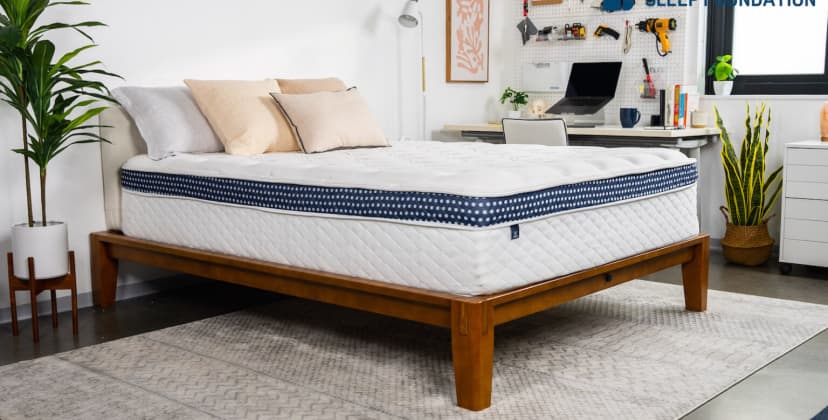
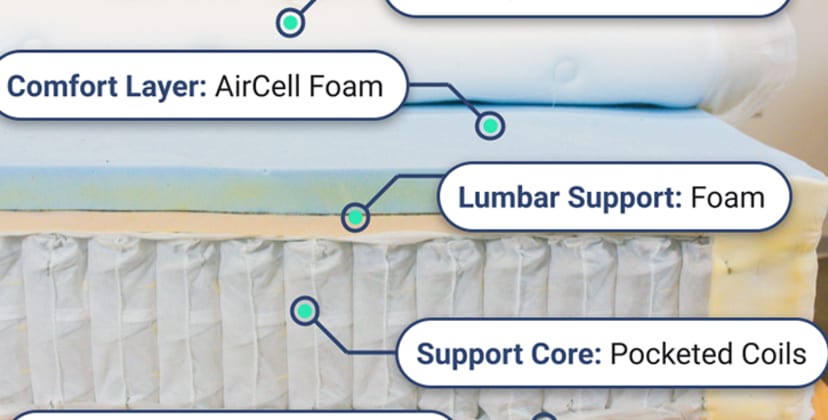

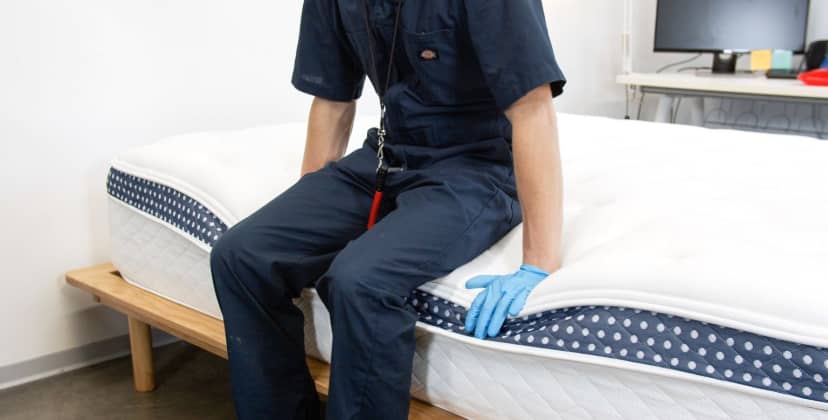
Credit: Sleep Foundation Test Lab
Price
$2,570
Mattress Type
Innerspring
Firmness Options
Medium Soft (4), Medium Firm (6), Firm (7), Firm (8)
Trial Period
120 nights (30 night requirement)
At a Glance
- Who It’s Best For: Sleepers of most body types and sleeping positions, depending on model.
- Feel: Medium soft (4), medium firm (6), firm (7), and firm (8). All are bouncy and breathable with supportive edges.
- What It’s Made Of: Moisture-wicking Tencel cover and a Euro-top quilted with gel-infused foams. Next, responsive foams with increasingly firmer support, with an extra foam pad. The support core is pocketed coils, reinforced around the edges and under the lower back.
- What We Don’t Like: Doesn’t offer the close “hug” of a memory foam model. Return fee of $49.
Scoring & Reviews
The following ratings show how suitable this mattress is for different sleeping positions and sleeper weights. These scores are determined by how well the mattress supports and relieves pressure for each sleeper type.
We performed a meta-analysis on 8573 validated customer reviews of the Winkbed. This is what people who bought the mattress had to say:- Pain Relief and Support: A significant number of users report alleviation of back, hip, and shoulder pain, attributing this to the mattress’s supportive design. Individuals with chronic back issues have noted substantial improvements in sleep quality.
- Comfort Across Sleep Positions: Reviewers from various sleep positions—side, back, and stomach—find the mattress comfortable. The availability of different firmness levels allows users to select options that best suit their sleeping style.
- Temperature Regulation: Many customers appreciate the mattress’s ability to stay cool, enhancing overall comfort throughout the night.
- Edge Support: Users frequently mention the robust edge support, which provides a stable and usable sleeping surface across the entire mattress.
- Firmness Options: Customers appreciate the variety of firmness options available, finding the right balance for their personal preferences.
- Durability and Craftsmanship: The mattress is often praised for its high-quality construction and materials, with users expressing confidence in its longevity. The lifetime warranty further reinforces trust in the product’s durability.
- Customer Service and Trial Experience: Customers value the 120-night risk-free trial and responsive customer service, noting that these factors contribute to a positive purchasing experience.
Best Mattress for Side Sleepers
Nolah Evolution 15
9.2 /10
Test Lab Score
35% off sitewide + extra $100 off with code: SF100
35% off sitewide + extra $100 off with code: SF100
The Nolah Evolution 15 features a substantial comfort section that’s optimized for pressure relief while side sleeping. Firmer materials in the middle third of the bed support your waist while allowing your hips and shoulders to gently sink in. This hybrid model is available in three firmness options to suit a wider variety of side-sleeping athletes.

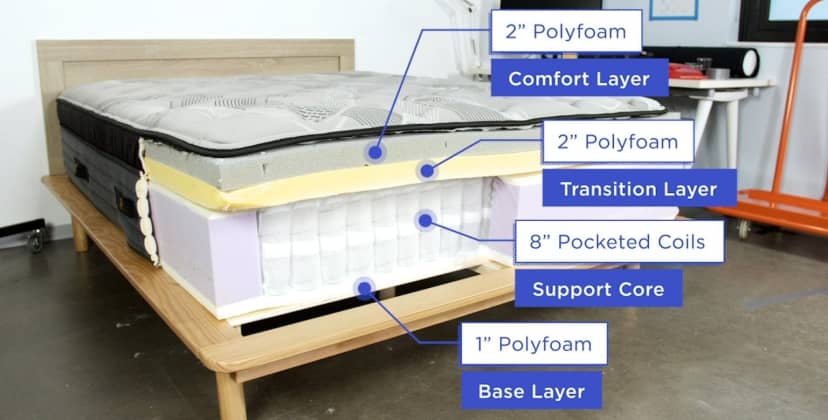

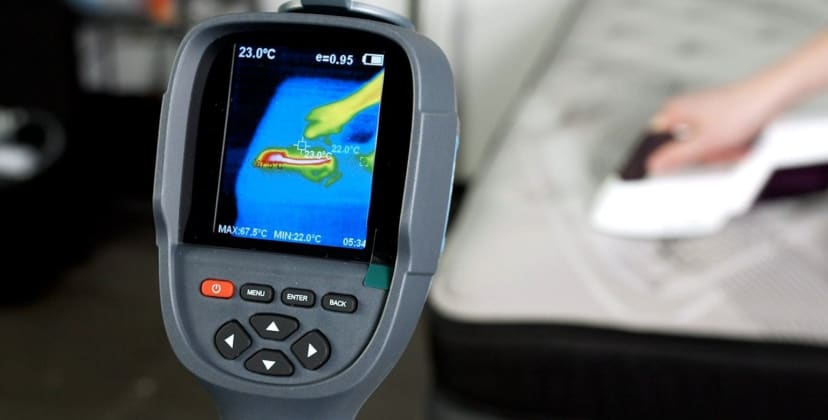
Credit: Sleep Foundation Test Lab
Price
$1,624
Mattress Type
Hybrid
Firmness Options
Medium (5), Medium Firm (6), Firm (8)
Trial Period
120 nights (30-night requirement), $99 return pickup fee
At a Glance
- Who It’s Best For: Side sleepers (softer models) and back and stomach sleepers (firmer options).
- Feel: Medium (5), medium firm (6), and firm (8) options. Performance varies, but expect a responsive surface and strong edges.
- What It’s Made Of: Quilted Euro-top cover with phase change material. Three layers of pressure-relieving polyfoam, including a zoned middle layer. The support core is pocketed coils that rest on a polyfoam base layer.
- What We Don’t Like: Requires deep pocket fitted sheets. Return fee of $99.
Scoring & Reviews
The following ratings show how suitable this mattress is for different sleeping positions and sleeper weights. These scores are determined by how well the mattress supports and relieves pressure for each sleeper type.
We performed a meta-analysis on 897 validated customer reviews of the Nolah Evolution 15. This is what people who bought the mattress had to say:- Motion Isolation: Couples note the excellent motion isolation, which minimizes disruptions from partner movements during the night.
- Edge Support: The edge support of the mattress is frequently highlighted, with many finding it adequate for sitting or sleeping near the edge without feeling like they will roll off.
- Softness: Many reviewers discuss the softness of the mattress. Some find it too soft, causing discomfort, especially for heavier individuals, while others appreciate the plushness.
- Pressure Relief and Support: Reviewers frequently highlight relief from back and shoulder pain, attributing this to the supportive foam layers and zoned coil system.
- Heat Retention: A few reviewers note that the mattress retains heat, making it uncomfortable for some, particularly in warmer climates or for those who sleep hot.
- Durability and Quality: Users often comment on the high quality and durability of the mattress, noting that it maintains its shape and comfort over time.
Best Mattress for Spinal Alignment
Silk & Snow Hybrid
7.8 /10
Test Lab Score
$150 off at Silk & Snow
$150 off at Silk & Snow
The Silk & Snow Hybrid’s foam-over-coil design contours to your curves to encourage a healthy and natural posture whether you’re on your side, back, or stomach. True to its hybrid roots, the mattress sleeps fairly cool and holds up well around the edges.
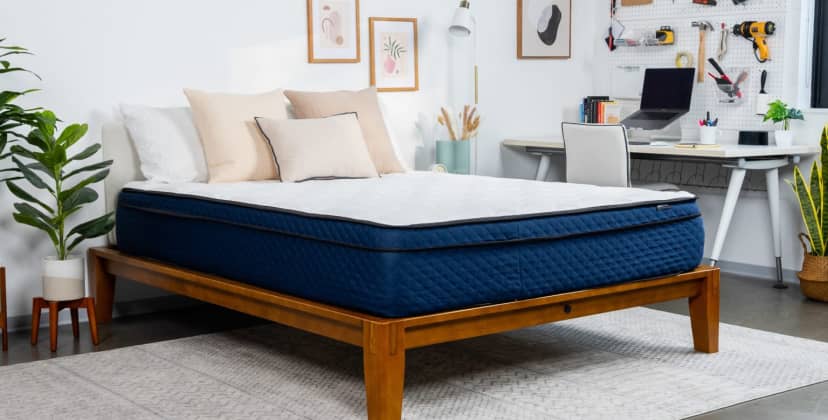
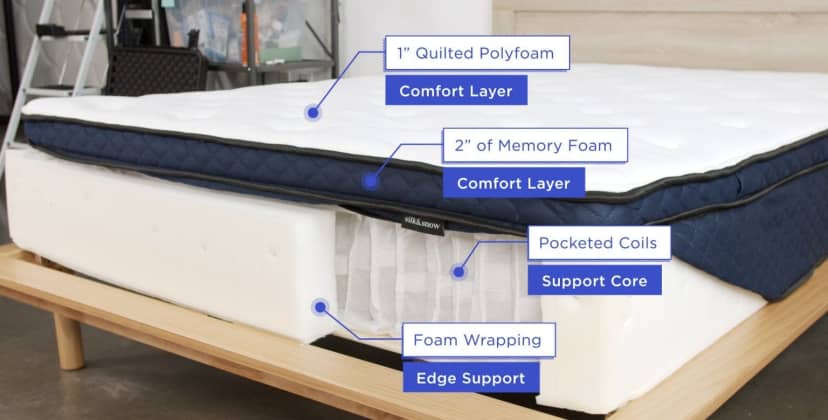
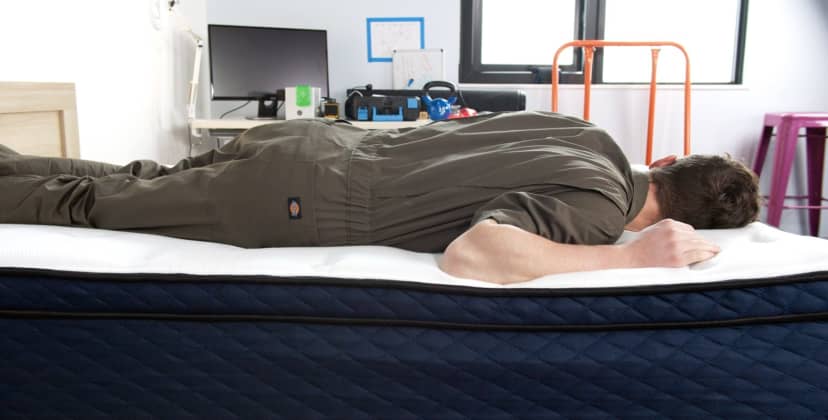
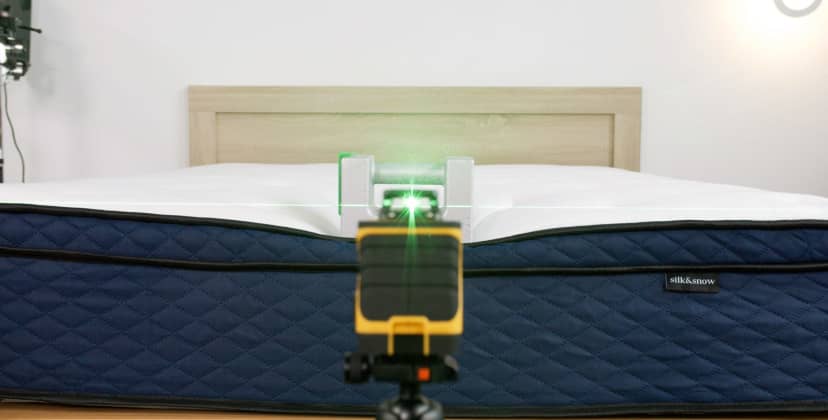
Credit: Sleep Foundation Test Lab
Price
$700
Mattress Type
Hybrid
Firmness Options
Medium Soft (4), Medium Firm (6)
Trial Period
365 nights (30-day requirement)
At a Glance
- Who It’s Best For: Side and back sleepers under 130 pounds (medium soft model). Heavier people and stomach sleepers under 130 pounds (medium firm).
- Feel: Medium soft models feel plush and adaptive, hugging your body closely. The firm design has lighter contour, and you won’t sink into the mattress as much.
- What It’s Made Of: Quilted foam cover, 2-inch layer of contouring gel memory foam, and a pocketed coil core with zoned lumbar support for better spinal alignment. The coils are made from strong, double-tempered steel and surrounded by a polyfoam encasement.
- What We Don’t Like: Both are too soft for stomach sleepers over 130 pounds.
Scoring Breakdown
The following ratings show how suitable this mattress is for different sleeping positions and sleeper weights. These scores are determined by how well the mattress supports and relieves pressure for each sleeper type.
We performed a meta-analysis on 3,831 validated customer reviews of the Silk & Snow Hybrid Mattress. This is what people who bought the mattress had to say:- Balanced: Owners say this bed has the perfect blend of comfort and great support, with side sleepers in particular calling it out as ideal for their needs.
- Firmness Level: The medium-firm model is true to its label, and provides a balanced feel between support and softness.
- Temperature Regulation: Customers agree that the Hybrid has excellent temperature control and offers a cool sleep experience for people who sleep hot.
- Durability: Customers report long-term satisfaction, with some noting the mattress is as comfortable after four years of daily use as it was on the first day.
- Customer Service and Delivery: Reviews mention timely delivery and positive experiences with customer service, enhancing the overall purchasing experience.
Best Mattress for Heavier Athletes
Titan Plus Luxe
8.4 /10
Test Lab Score
30% off sitewide
30% off sitewide
The Titan Plus Luxe is an exception to the typical mattress built for heavier individuals, which tend to use a firm sleep surface to prevent sinkage. By contrast, the Titan Plus Luxe is medium firm, offering cushioning to soothe aching muscles while still providing sturdy spinal support. The mattress uses sag-resistant foams to minimize the chances of developing premature body impressions.
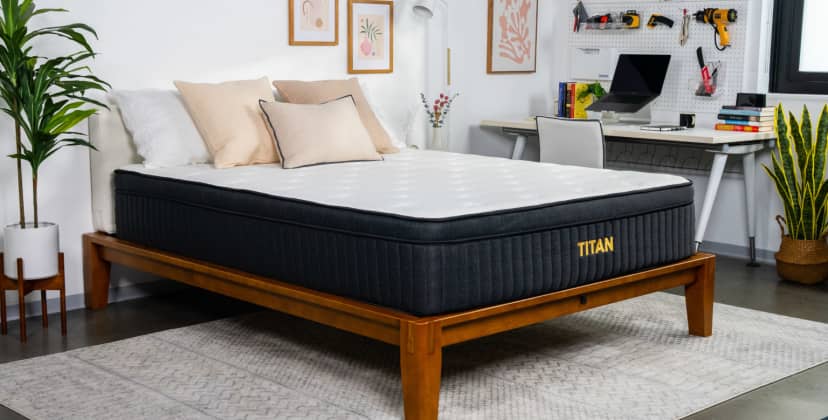
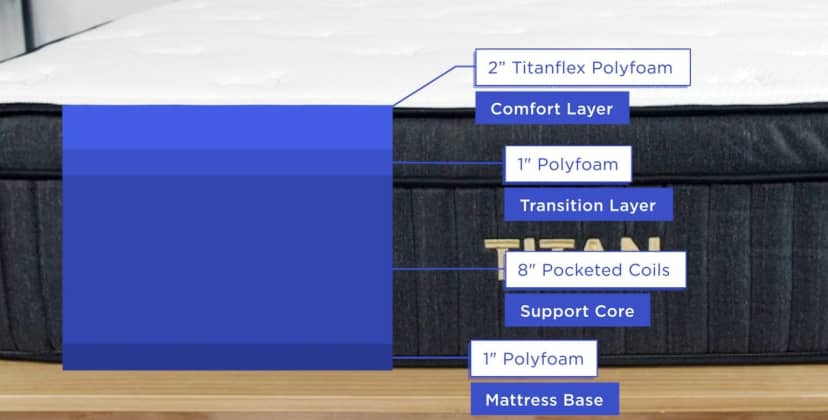


Credit: Sleep Foundation Test Lab
Price
$1,312
Mattress Type
Hybrid
Firmness Options
Medium Firm (6)
Trial Period
120 nights (30-night requirement, $99 return fee)
At a Glance
- Who It’s Best For: People up to 500 pounds (1,000 pounds total if sleeping with a partner), particuarly side sleepers over 130 pounds and back sleepers between 130 and 230 pounds.
- Feel: Medium firm (6), with an initial layer of plushness that cedes to the firmer support layer below and strong edges.
- What It’s Made Of: Gel-quilted cover, with an optional cooling cover for an additional fee. Next are two foam layers, followed by an 8-inch pocketed coil core. The bed sits on a 1-inch layer of high-density polyfoam.
- What We Don’t Like: Too firm for those less than 130 pounds, especially side sleepers. Return fee of $99.
Scoring & Reviews
The following ratings show how suitable this mattress is for different sleeping positions and sleeper weights. These scores are determined by how well the mattress supports and relieves pressure for each sleeper type.
We performed a meta-analysis on 1931 validated customer reviews of the Titan Plus Luxe. This is what people who bought the mattress had to say:- Firmness Level: The Titan Plus Luxe mattress offers a firm support that is appreciated by those who need it, but may be too firm for many, likened to “sleeping on plywood” by one user.
- Supportive for Plus Size: Specifically designed to be supportive for plus size individuals, many reviewers found the mattress to be supportive and comfortable, helping alleviate back pain.
- Edge Support Issues: Several users reported that the edge support of the mattress is lacking, making it difficult to sit on the edge or causing a feeling of instability.
- Motion Transfer: Some users experienced noticeable motion transfer on the mattress, which could be disruptive for people who share the bed.
- Odor: A few users noted a chemical smell upon unboxing the mattress, which could be off-putting, though this will dissipate in a few days.
- Positive Customer Service Experiences: Many reviewers highlighted excellent customer service, particularly appreciating the easy return and exchange policies when the mattress did not meet their expectations.
Best Mattress for Shoulder Pain
Lulu Original Mattress
7.7 /10
Test Lab Score
$999 from Lulu (queen)
$999 from Lulu (queen)
If your shoulders hurt from your workout, you may find relief with the Lulu Original Mattress, which uses pressure-relieving memory foam to soothe tender areas. Other benefits of the Lulu include strong motion isolation and surprisingly reliable edges for a foam mattress.
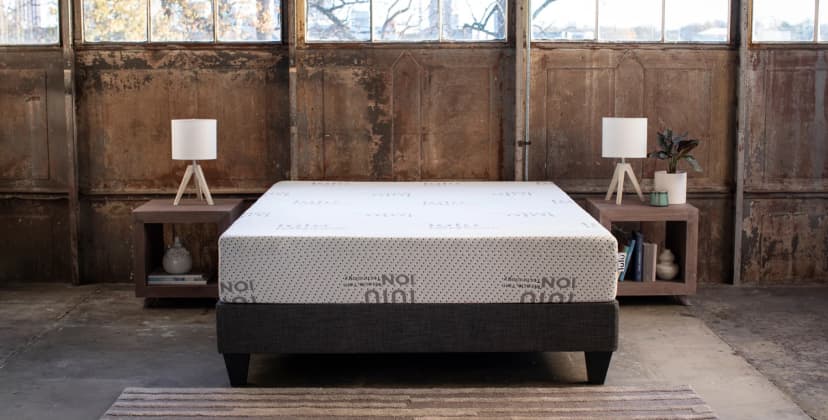
Price
$999
Mattress Type
Foam
Firmness Options
Medium Firm (6)
Trial Period
101 nights (28-night requirement)
At a Glance
- Who It’s Best For: Side sleepers, particularly those between 130 and 230 pounds.
- Feel: Medium firm (6) with the familiar “hug” and fairly slow response to pressure that’s characteristic of memory foam.
- What It’s Made Of: ION cover fabric, which contains mineral fibers, followed by gel-infused memory foam and a polyfoam support core.
- What We Don’t Like: Some heat buildup. Can be a bit difficult to change positions for some.
Scoring Breakdown
The following ratings show how suitable this mattress is for different sleeping positions and sleeper weights. These scores are determined by how well the mattress supports and relieves pressure for each sleeper type.
The Best Deals of the Week
-
Save $199
—
Brooklyn Bedding CopperFlex Memory Foam
$466 (List Price $665) -
Save $600
—
Helix Midnight Luxe
$1,799 (List Price $2,399) -
Save $2,436
—
Nectar Adjustable Bundle
$1,398 (List Price $3,834) -
Save $771
—
WinkBed
$1,799 (List Price $2,570) -
Save $1,020
—
DreamCloud Classic Hybrid
$699 (List Price $1,719)
Best Mattress Overall
Bear Elite Hybrid
8.5 /10
Test Lab Score
40% sitewide with code: SF40
Shop NowA mattress specifically designed to enhance muscle and joint recovery.
See More Details
Best Value Mattress
Layla Memory Foam Mattress
8.4 /10
Test Lab Score
Get an extra $10 off with exclusive code: sleepy10
Shop NowA flippable mattress with two firmness options for the price of one.
See More Details
Most Comfortable Mattress
Helix Midnight
9.1 /10
Test Lab Score
25% off sitewide
Shop NowPlush yet responsive foams paired with a supportive coil core.
See More Details
Best Mattress for Muscle Recovery
Brooklyn Bedding Spartan
8.4 /10
Test Lab Score
30% off sitewide
Shop NowA hybrid mattress optimized for recovery with innovative ion technology.
See More Details
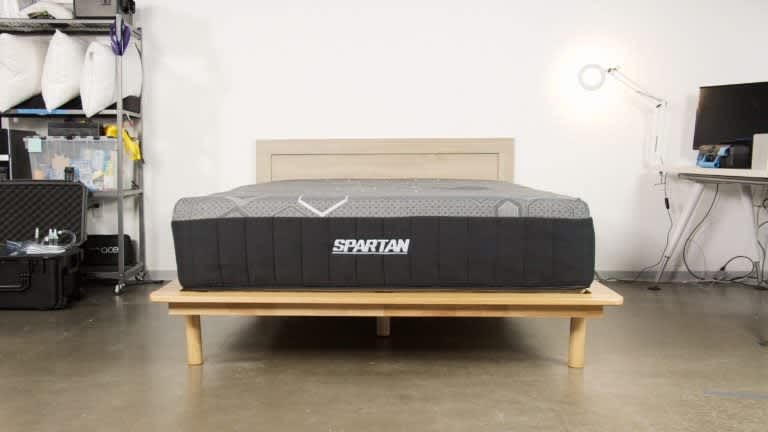
Credit: Sleep Foundation Test Lab
Best Mattress for Back Pain
WinkBed
9.4 /10
Test Lab Score
30% off all WinkBeds mattresses
Shop NowA well-constructed hybrid with multiple layers of zoned support to alleviate sports-related back pain.
See More Details
Best Mattress for Side Sleepers
Nolah Evolution 15
9.2 /10
Test Lab Score
35% off sitewide + extra $100 off with code: SF100
Shop NowThick foam layers provide cradling pressure relief for physically active side sleepers.
See More Details
Best Mattress for Spinal Alignment
Silk & Snow Hybrid
7.8 /10
Test Lab Score
$150 off at Silk & Snow
Shop NowA balanced memory foam hybrid that supports healthy posture for athletes
See More Details
Best Mattress for Heavier Athletes
Titan Plus Luxe
8.4 /10
Test Lab Score
30% off sitewide
Shop NowDurable foams and coils provide long-lasting support for muscular bodies.
See More Details
Best Mattress for Shoulder Pain
Lulu Original Mattress
7.7 /10
Test Lab Score
$999 from Lulu (queen)
Shop NowA cushy all-foam bed that contours deeply to alleviate pain and pressure for athletic sleepers.
See More Details
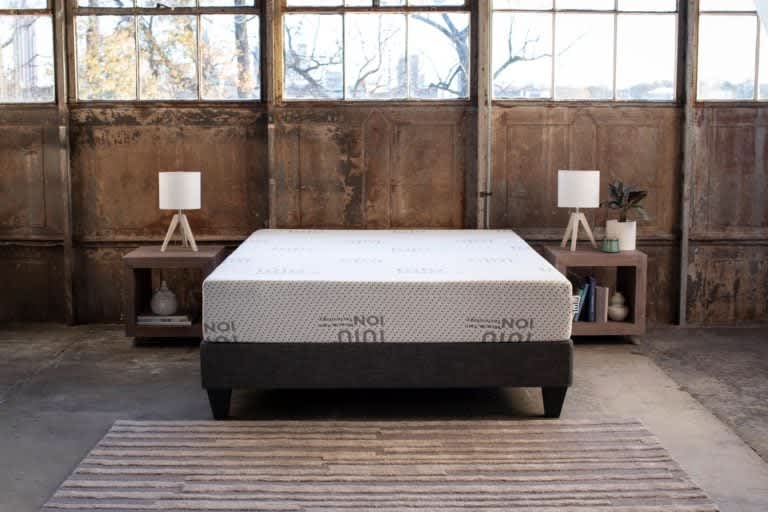
Why Sleep Is Important for Physical Activity
For athletes and physically active individuals, quality sleep is just as important as training and nutrition when it comes to performance.
Lack of proper rest can lead to slower reaction times, decreased endurance, and a higher risk of injury, making it harder to perform at your best. A supportive, pressure-relieving mattress can improve sleep quality by promoting muscle recovery, reducing joint strain, and ensuring proper spinal alignment, so you wake up feeling refreshed and ready to take on your next challenge.
How to Choose a Mattress for Athletes
Some mattresses are designed specifically with athletes and other physically active people in mind. They are constructed with pressure-relieving comfort layers, support materials that won’t sag too much, and innovative covers engineered to alleviate aches and pains even after your toughest days at the gym.
As you shop for a new mattress, you’ll undoubtedly notice plenty of marketing hyperbole, such as “universal comfort,” “forever lifespan,” or “the perfect bed.” Ignore this jargon. You should select a new mattress based on your personal preferences and needs as a physically active person. The factors below should be your most important considerations.
Firmness Level
Firmness is measured on a 1-10 scale, with 1 being the softest and 10 the firmest. Softer mattresses usually conform more closely, so if you experience frequent pressure points or you sleep on your side and want better spinal alignment, a bed with a 3 to 5 rating will probably be most comfortable. Lighter people also tend to prefer softer beds.
Firmer mattresses do not contour as much, but they keep sleepers on an even plane using high-density foam, coils, and other supportive materials. This makes them well-suited for heavier people who sink too much on softer beds, especially back and stomach sleepers who need extra reinforcement.
If your firmness preferences fluctuate, then a mattress with adjustable firmness might be the way to go. Many couples also have different preferences, and in these cases, we recommend a mattress with dual-firmness. This allows you and your partner to enjoy your preferred balance of comfort and support.
Pressure Relief and Contouring
Some people want a deep body cradle while others like to sleep on a flush, even surface that barely sinks. If you’re unsure which contouring level is best for you, online sleep trials can also help you narrow down your ideal setting.
If you experience pressure points due to physical activity or other reasons, you should seek out mattresses that conform closely enough to your body without sinking, sagging, or losing support. Consider your body type and sleep position, as well.
Temperature Regulation
A mattress with good breathability and moisture-wicking properties prevents overheating. Hybrids have good airflow because of their coil systems, and latex promotes breathability by not conforming too closely.
Temperature regulation ensures that the body can maintain a balanced temperature, promoting deeper, more restful sleep, which is essential for muscle repair, reducing inflammation, and boosting overall energy levels.
Thickness
Mattress thickness affects support and ease of getting on and off the bed. Athletes’ needs vary, but body type and sleep position are key factors for choosing the right mattress. Low-profile mattresses (under 10 inches) may not be supportive enough for heavier people, while high-profile ones (over 12 inches) tend to be softer and easier to get on and off. Medium-profile mattresses (10-12 inches) offer a balance of comfort and support.
Our recommendation: Test out a few different mattress profiles either in a brick-and-mortar store or using online mattress brand sleep trials. These experiences can help you decide which profile range will be most suitable for your needs and active lifestyle.
Price
While high-end mattresses often come with advanced cooling, pressure relief, and zoned support, budget-friendly options can still provide the essential features needed for quality rest.
Look for the best value rather than just the lowest price, prioritizing materials and construction that enhance muscle recovery, improve spinal alignment, and regulate temperature. A mattress is an investment in long-term health and performance, so finding a balance between affordability and quality ensures better sleep without unnecessary spending.
Quality of Materials
Mattress materials are linked to durability. High-density foam, organic latex, thick coils, and other components will probably last longer than materials of lesser quality. Materials also impact breathability, pressure relief, edge support, and other performance factors.
Edge Support
A mattress with reinforced edges provides a stable sleep surface, preventing excessive sinkage when sitting or lying near the perimeter. This is especially beneficial for larger or more muscular individuals, as it maximizes usable space and ensures better support when getting in and out of bed. Additionally, good edge support enhances durability, ensuring the mattress maintains its shape and structure over time.
Ease of Movement
A bed that allows for smooth position changes prevents sleepers from feeling “stuck,” which is especially important for those with sore muscles or joint stiffness. Responsive materials, such as latex or hybrid designs with pocketed coils, provide a balance of contouring and support without excessive sinkage, making it easier to shift positions or get out of bed after an intense workout. Choosing a mattress that promotes easy movement helps athletes avoid discomfort and maintain undisturbed, high-quality sleep for optimal recovery.
What Type of Mattress Is Best for Athletes?
Mattresses can use a wide array of materials, but most models can be classified as one of the five main types. Individual mattress models may have some variations, but most mattresses in the same category share some similar traits.
Hybrid
Definition: Hybrid mattresses combine a coil core with a comfort system that may contain memory foam, polyfoam, latex, microcoils, wool, or a combination of materials. This design aims to fuse the benefits of multiple types of mattresses without as many potential drawbacks.
Highlight: Balanced Pressure Relief and Temperature Regulation. Hybrid models are typically a good fit for athletes because they strike a balance between cushioning and support. They usually have thick comfort layers that can help relieve aches and pains while their coils provide good pushback.Their coil cores also allow good airflow.
Foam
Definition: Memory foam and polyfoam are the most common materials used in all-foam models. Most use memory foam in their comfort systems, though models can be constructed entirely of polyfoam for a firmer, springy feel.
Highlight: Pressure-Relieving Hug. Foam mattresses, especially those that use memory foam, are known for their hug. This close contouring can help redistribute the sleeper’s weight to ward off pressure buildup, so foam mattresses can be a good fit for athletes with sore muscles.
Innerspring
Definition: Innerspring models are a more traditional design made primarily of springs. While the bulk of an innerspring is its coil core, some also contain thin comfort layers. Since they have been on the market for a long time, innersprings also tend to be more affordable.
Highlight: Breathability. Air flows through coil systems, so innerspring models tend to be quite breathable. Innerspring models don’t conform closely and have a traditional, bouncy feel that some sleepers prefer. That said, if you tend to experience pressure points, an innerspring may not provide enough cushioning for you.
Latex
Definition: Latex foam is made using the sap of rubber trees, and there are also synthetic and blended versions. There are two main types depending on how the latex is processed. Talalay latex has a bouncier feel and is generally more breathable, making it a popular choice for comfort layers. Dunlop latex is usually denser and more durable. It may be used in a comfort layer or support core.
Highlight: Contouring Without Much Sinking. Latex tends to compress over a wider area when weight is applied. It usually contours enough for good pressure relief, but it doesn’t allow as much sinking as all-foam models. Many sleepers liken this to a floating sensation.
Airbed
Definition: Airbeds get their name from the air chambers that serve as their support system. A crank, app, or remote is used to fill and empty the chambers to change the bed’s firmness level. Some airbeds also contain thin comfort layers for extra cushioning on the surface of the bed.
Highlight: Adjustability. The chambers of an airbed are usually easy to fill or empty, and doing so adjusts the firmness of the bed. The flexibility of airbeds can be helpful for athletes whose firmness preferences might change depending on their training regimen. Many airbeds use separate air chambers on either side of the bed, so they’re also a good fit for couples with different firmness preferences.
How Athletes Can Get Better Sleep
If you’re a physically active person, there are many ways to optimize your sleeping environment apart from choosing the right mattress. These include maintaining a comfortable sleep temperature and reducing your exposure to outside noise. You can also invest in additional products to enhance your sleep experience.
Pillows
Pillow selection is, arguably, just as important as mattress selection. The right pillow provides enhanced support to your head, neck, and shoulders, and also supports the spine. The wrong pillow can have the opposite effect, leading to added aches and pains, as well as spinal misalignment.
The best pillow will offer enough cushioning to fill the gaps between your head and shoulders. Pillows fall into three general loft, or thickness, categories:
- Low loft: less than 3 inches
- Medium loft: 3 to 5 inches
- High loft: more than 5 inches
When choosing a pillow loft, be sure to consider your bed’s firmness level. A softer bed will conform more closely, causing you to sink beneath the surface, so a low-loft pillow might provide sufficient padding. For a firm mattress that contours very little, a high-loft pillow to fill the extra space may be the best option.
The best pillow loft also depends on your sleep position. While preferences vary by person, the table below lists optimal loft for most people based on how they sleep.
| Sleeping Position | Recommended Pillow Loft |
|---|---|
| Back | Medium |
| Side | Medium to high |
| Stomach | Low |
Also, be sure to consider pillow fill and density. Fill refers to the materials inside the pillow, and density refers to how heavy these materials are. Some fills have a higher density and will not compress as easily, creating a more stable and supportive surface for your head. Less dense materials will sink and conform closely, and may not provide enough neck support – especially if you are a physically active person dealing with neck or shoulder discomfort.
Mattress Toppers
A mattress topper is a layer of cushioning that rests on top of the bed’s surface. Toppers are designed to change the firmness of a sleep surface. Most toppers make the surface feel softer, but some can add a firmer feel. For this reason, toppers are widely used for pull-out beds, RVs, and other sleeping areas where the mattresses are less than ideal.
A topper may also be helpful if you are dissatisfied with the firmness of your mattress, but can’t return or exchange it because your sleep trial has expired. Many mattresses adopt a different feel over time, and those with thick foam layers may lose shape as the material begins to deteriorate. Most toppers measure 2 to 5 inches thick, so using one is basically equivalent to adding a fresh comfort layer to your mattress. Toppers are also generally inexpensive, especially compared to buying a new bed.
Toppers tend to have shorter lifespans, so using one is, in all likelihood, a short-term solution to a permanent mattress problem. However, these layers may provide more comfort and pressure relief than your bed’s comfort layer, especially if you are physically active and want your sleep surface to promote physical recovery.
Sleep Hygiene
Healthy sleep habits are important for everyone, but athletes requiring recovery may find them especially advantageous. Try the following tips to help improve your sleep quality.
- Stick to a consistent sleep schedule with regular sleep and wake times.
- Make sure your room is dark and quiet, and use a sleep mask and/or earplugs if needed.
- Avoid caffeine late in the day.
- Don’t exercise vigorously within one hour of bedtime.
- Cut out alcohol and avoid heavy meals too close to bedtime.
- Wind down before bed with a relaxing routine like journaling, yoga, or reading.
- Get plenty of sunlight, especially first thing in the morning
How We Test: Your Comfort Is Our Science
Our industry-leading product testing team cares deeply about improving your sleep. Having a holistic understanding of a mattress’s role as part of a sleep system is paramount to our testing process. Since a bed’s comfort and feel depend largely on body weight and sleeping position, our testing team represents a wide range of body types, sleep positions, and comfort preferences.
In our Seattle-based Test Lab, we use an objective, hands-on process to evaluate mattresses across performance categories. The following are the key guidelines that inform our performance ratings. Our ultimate goal is to ensure you have all the information you need to make the best purchase decision for you.
Construction analysis: Mattress construction plays a major role in our ratings system. We begin our testing with a top-to-bottom analysis of each mattress, making note of its materials, firmness, thickness, and other physical attributes. Price-point is another major factor as we assess quality of materials and overall value.
Quantitative product testing: For hands-on testing, our team members take turns lying and moving on each mattress. This immersive process helps us evaluate beds for performance categories like motion isolation, pressure relief, ease of movement, and temperature control.
Field testing: Once we’re finished testing a mattress in our lab, one of our team members takes it home and sleeps on it in their own bedroom for two to three weeks. Field testing helps us understand how each mattress performs in the long term.
User feedback: In addition to our team’s testing data, we draw from customer surveys and product reviews to calculate our final ratings. This helps us ensure our findings are consistent with real-world experiences.
How We Determine Our Overall Scores

To determine a mattress’s overall score, we assign weighted percentages to performance categories based on how important they are to the individual sleep experience. For instance, areas like pressure relief and temperature control tend to matter more to people than something like off-gassing, and because more people sleep on their side and back than on their stomach, we weigh those positions more heavily.
Performance Categories
Motion Isolation
This refers to the amount of motion a mattress absorbs when a sleeper moves on the surface. To evaluate motion isolation, we use two testers lying side by side who each feel for transfer while the other person moves on the mattress.
Temperature Control
To determine how well a mattress regulates temperature, we perform temperature tests and look closely at its materials and construction. Many mattresses are designed with cooling components meant to reduce heat retention.
Pressure Relief
A bed with strong pressure relief excels at preventing pressure from building up in areas like the shoulders and hips. Beds with even contouring and weight distribution are top performers when it comes to pressure relief.
Off-Gassing
A mattress in a box may release unpleasant chemical odors for a short period after you’ve unboxed it. The initial smell may be strong but typically fades within 2 or 3 days.
Ease of Movement
This reflects how easily a sleeper can move across a bed’s surface. Responsive surfaces made of latex typically perform better than foam surfaces, which can inhibit movement.
Edge Support
We perform sit tests along a bed’s perimeter to measure how well the edges push back against weight. Mattresses with strong edge support have minimal sagging when sleepers sit on or lie close to the perimeter.
Dive Deeper – Mattress Guides by Sleeper Type
If you’re not certain any of these choices are the right one for your needs, you can read through our recommendations categorized by sleep styles.
Best Mattress by Sleeper Type
- Best Mattress for Lightweight Sleepers
- Best Mattress for Couples
- Best Mattress for Kids
- Best Mattress for Toddlers
- Best Mattress for Teenagers
- Best Mattress for Seniors
- Best Cooling Mattress for Hot Sleepers
- Best Tempur-Pedic Mattress for Side Sleepers
- Best Tempur-Pedic Mattress for Back Sleepers
- Best Tempur-Pedic Mattress for Stomach Sleepers

Still have questions? Ask our community!
Join our Sleep Care Community — a trusted hub of product specialists, sleep health professionals, and people just like you. Whether you’re searching for the perfect mattress or need expert sleep advice, we’ve got you covered. Get personalized guidance from the experts who know sleep best.

